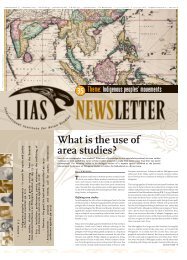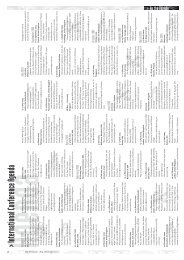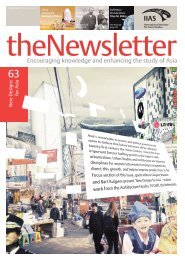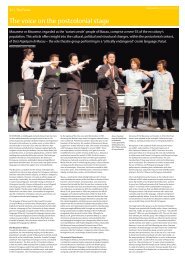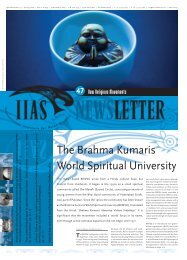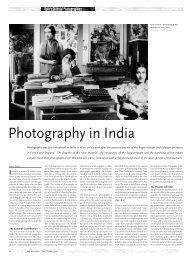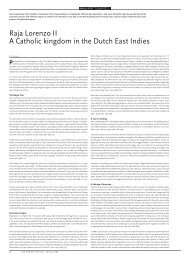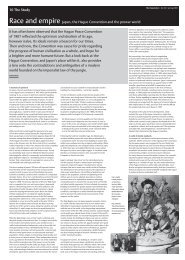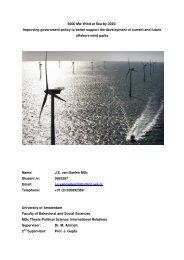Sex, love and revolution - IIAS
Sex, love and revolution - IIAS
Sex, love and revolution - IIAS
Create successful ePaper yourself
Turn your PDF publications into a flip-book with our unique Google optimized e-Paper software.
R E V I E W<br />
Theuns-de Boer, Gerda. 2008. A Vision of Splendour: Indian Heritage in the Photographs of Jean Philippe Vogel, 1901-1913 Mapin Publishing <strong>and</strong><br />
The Kern Institute. 191 pages. 149 B/W photographs. ISBN 978 0 944 14274 5<br />
Photography, archaeology <strong>and</strong> afternoon tea<br />
G<strong>and</strong>haran Buddhas. Loriyan Tangai<br />
(NW Frontier Province, Pakistan); overview<br />
of excavated Buddhist sculpture,<br />
2nd-5th century. Alex<strong>and</strong>er E. Caddy,<br />
1890s.<br />
Upinder Singh<br />
In 1901, a young Dutchman named Jean Philippe Vogel arrived in<br />
Lahore, fresh from the successful defence of his doctoral thesis on the<br />
Mrichchhakatikam (‘The Little Clay Cart’), a well-known work of Sanskrit<br />
literature. He had come to India to continue his Sanskrit studies <strong>and</strong> to<br />
get a taste of Indian culture. Instead, his potential was noticed by Marc<br />
Aurel Stein, a Sanskritist <strong>and</strong> archaeologist working in India, <strong>and</strong> he was<br />
inducted into the Archaeological Survey of India (ASI) as an archaeological<br />
surveyor in the Punjab, Baluchistan <strong>and</strong> Ajmer Circle.<br />
At the time of joining the ASI, Vogel knew nothing about archaeology.<br />
Nevertheless, it was not altogether surprising that he should have been<br />
considered for the job, as many of the officers of the ASI were in fact textual<br />
scholars, who had learnt archaeology while on the job. Over the years,<br />
Vogel found himself playing an important role in excavating major sites<br />
such as Charsada, Kusinara <strong>and</strong> Saheth-Maheth. He wrote fine, meticulously<br />
detailed scholarly works on a wide variety of themes including the<br />
medieval monuments of Lahore, Delhi <strong>and</strong> Agra, the art of the Punjab Hill<br />
states, the sculpture of Mathura, <strong>and</strong> serpents in Hindu legend <strong>and</strong> art.<br />
In 1910, he rose to the position of Deputy Director General of the ASI, a<br />
post he occupied till 1912. Vogel left the ASI in 1914, to take up a professorship<br />
in Sanskrit at Leiden University. He retired in 1939 after 12 extremely<br />
fruitful years of archaeological work in India <strong>and</strong> a quarter of a century of<br />
academic work in Leiden.<br />
Vogel was not only a gifted <strong>and</strong> industrious scholar, he was also an institution<br />
builder. In 1924, along with Nicolaas Johannes Krom, he founded<br />
the Kern Institute in Leiden. The institute was named after the first Dutch<br />
Sanskritist, Hendrik Kern (1833-1917), <strong>and</strong> swiftly became a major centre<br />
of Indology in Europe. The Kern Institute also became home to Vogel’s<br />
collection of some 10,000 photographs. These photographs were taken<br />
variously by amateurs, professional photographers, <strong>and</strong> officers of the<br />
ASI. Some were taken by Vogel himself. The images cover not only India,<br />
but also Sri Lanka, Thail<strong>and</strong>, Burma <strong>and</strong> Cambodia.<br />
Gerda Theuns-de Boer’s A Vision of Splendour contains a selection of some<br />
150 photographs from this archive, all taken between 1870 <strong>and</strong> 1920. Con-<br />
Kusinagara, Colossal statue of<br />
a seated Buddha before <strong>and</strong><br />
after restoration, ca. 12th century.<br />
Ghulam Nabi, 1911.<br />
3 0 I I A S N E W S L E T T E R # 4 8 S u m m e r 2 0 0 8



